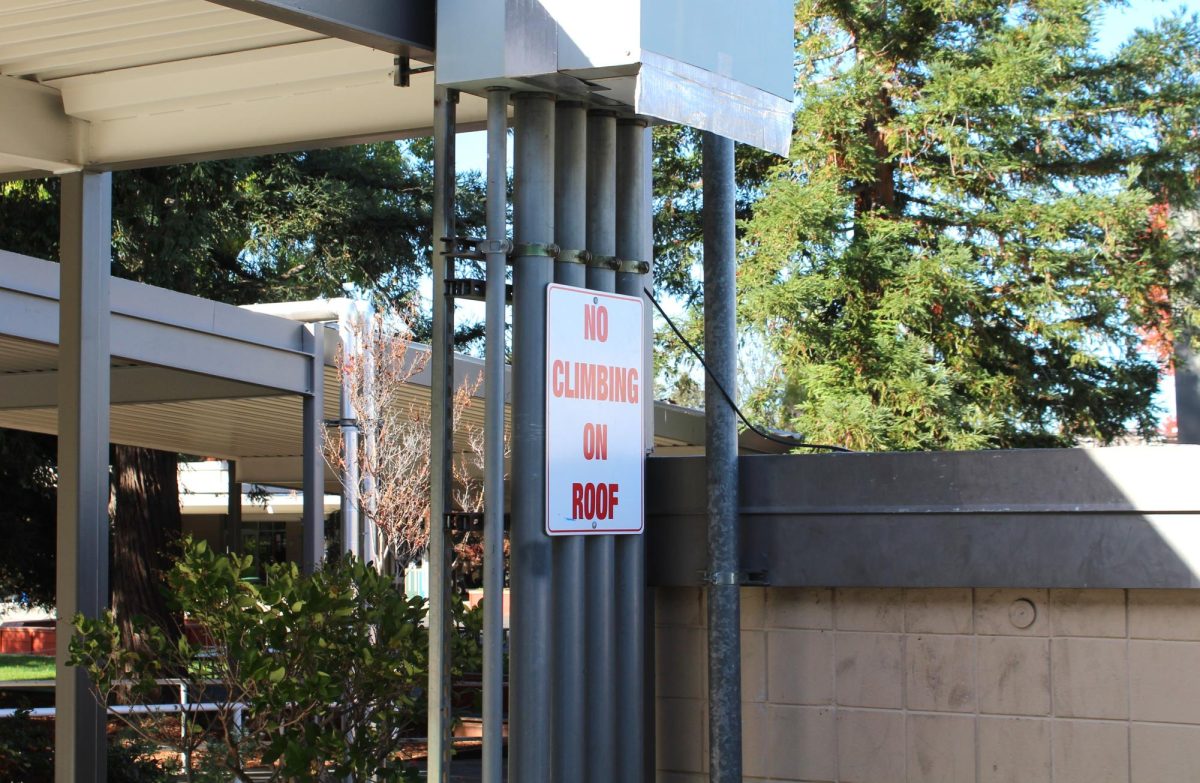During his time on campus from 1964 to 1965 in his senior year, alumnus Steven Spielberg, the “highest-grossing film director in history,” recalled the school as “hell on Earth.” At the time, he experienced heavy antisemitism and felt isolated, occupying himself in journalism as a sports reporter for The Falcon and continuing his fascination with the world of film as documented in the recent autobiographical film “The Fablemans.”
Now, nearly 60 years later, two Saratoga High alumni describe the Media Arts Program (MAP) as a place where they have developed lifelong friendships and discovered how to express their voices through film, a complete turnaround from the time Spielberg was a student at the school long before it was a hotbed of student filmmaking.
Luke Salin (Class of 2016): a legacy of service
Salin grew up watching typical American films — “Toy Story 2,” “Twilight Zone,” “Star Wars,” “Indiana Jones” and of course, Spielberg’s movies, including “Catch Me If You Can,” “Raiders of the Lost Ark,” “Jurassic Park” and “Jaws,” all of which he enjoyed from an early age for its diversity and ability to appeal to a wide range of audiences.
“I think it’s funny. I feel like I was never interested in going into film or even TV at all, having to watch the same movies 12 times growing up because I was really scared of loud noises and intense action,” he said.
Years later, when his older sister, class of 2010 alumna Mikenna Salin, took the late Steven McCue’s photography class, Luke Salin discovered the behind-the-scenes workings of the camera. He was hooked. He took McCue’s art class in his freshman year and joined MAP, where he started to look at movies from a different viewpoint: as an art form that allowed him to communicate ideas.
A decade later, he now works as a creative advertising coordinator at Bleecker Street Media in New York City. Salin said he is still inspired by Spielberg’s ability to “capture something heartfelt and special in all his films” and create things that people enjoy for different reasons, a “special feat” that he says stands the test of time and is more motivating than any particular aesthetic style.
Looking back, Salin thinks the biggest takeaway from MAP is the teamwork mentality that was instilled in him, a quality that also allowed him to embrace a more open mindset. Salin described his teamwork philosophy as making the most of everyone’s opportunity to have a good time by being an active contributor to the surrounding environment — whether that means helping to create a work that’s technologically skilled or just being a good friend, both of which are “equally valuable.”
“Working with other people will make or break any experience in any project: the better the experience can be for everybody, the better the product will be,” he said. “MAP fosters that mentality really well and gives you the tools and opportunity to practice it. The excitement and willingness to try different things allowed for a great and challenging way to learn. As you get older and older, that’s not something that gets afforded as easily.”
During his senior year, MAP teachers unveiled an annual award named to honor his high level of support for others while in high school: the Luke Salin Outstanding Service Award. It honors students for their teamwork and collaboration skills.
For Salin, the award remains to be one of the “coolest things” that has ever happened to him. He said he still keeps in touch with many of his MAP friends above and below his grade, something that attests to the long-lasting bonds developed as a result of the program.
“I have so much appreciation and admiration for the teachers and the program itself — to know that I contributed to it, have left some kind of impact and hopefully encourage other students in the future to go into that mentality of service is super special and meaningful to me,” he said.
In addition to Salin’s teamwork mentality, longtime MAP teacher Joel Tarbox also noted that his “unique vision set him apart.” When asked to translate what his former teacher could have meant, Salin smiled and shook his head. He attributed his vision to his mindset at the time — believing that “high school Luke could do anything with his team” — and the imagination, creativity and willingness to “just go for it” that came with it.
At New York University (NYU), Salin was able to further build on that vision. In particular, he took Set in Sound Filmmaking during his sophomore year, an intense, one-semester class that split students into groups of four and required each student to direct five film projects. Through trial and error navigating the quick-paced nature of the class, Salin said he was able to discover what he enjoyed doing the most: not just the aspects of developing, capturing and sharing an idea visually, but going through the process with a team.
“There’s kind of a magic feeling when you can get it all to click and work out,” Salin said. “I think I first found that in MAP and then continued finding that in college. Even when things were hard, it felt like a bright flashing sign that was telling me I was heading the right way.”
One of the biggest projects Salin worked on was his undergraduate thesis project “Parked in America,” a half-hour dramedy that follows a Korean high schooler forced to move in with her cousins in the U.S. after experiencing a traumatic event. Salin began the project during his junior year at NYU with Kayla Lewis, one of his best friends, who wrote the script based on her personal experience as a Korean American. For Salin and Lewis, the film was about figuring out their identity as half-Asians, processing grief and paving their way forward.
It was also the first time Salin was able to “inject some of [him]self into the stuff [he] made,” an experience he hopes to continue for its more personal and gratifying style.
The TV pilot world-premiered at South By Southwest in 2021 and played at nine festivals nationwide, including locally at Cinequest in San Jose.
In addition to his NYU projects, Salin said that New York City also helped push him out of his comfort zone, take more risks and “grow up.” The city opened his mind to “total other corners” not only in entertainment, but also new perspectives in other kinds of art and politics.
“As someone who grew up in Saratoga, which is a pretty privileged bubble, you might not feel like there’s a lot going on, but I was able to find the feelings and memories that could be shared and helped me grow by working on that project,” Salin said. “It’s a cathartic personal experience, like I was communicating one to one with the audience as if they were my diary, which is why I think a lot of people like doing film and art in general.”
Salin said his project characterizes the experiences that many young people like him feel: The struggle of figuring out what to share with the world comes with gaining more life experience and is a process that changes an individual’s identity constantly. He said that such a process doesn’t just apply for an artist — it applies for being a person as well. And it can be tough for people coming from an isolated place like Saratoga.
“I’m still figuring out my personal style. That’s the real honest answer,” he said.
Besides his full-time job at Bleecker Streets Media, Salin is taking a temporary pause from making films. While he said that he feels that he currently lacks the inspiration and financial capability to carry out independent projects, Salin acknowledges that there are “a lot more important things going on in the world and thus more important stories to be told and heard” than what he feels he can contribute at the moment.
“I know I’ll find my way back to making my own films sometime soon,” he said. “It’s a long and taxing journey to push for your own talent in entertainment.”
For now, he enjoys learning about the industry from the “bottom of the corporate ladder.” Salin said working in the Indie film industry is rewarding and educational, as his work experience will enrich his life experience, a factor he said is crucial to become a better storyteller.
“Fortunately, I have lots of talented friends and coworkers, so being able to support and work with them is another way to feel like I’m still pushing myself into the industry with them,” Salin said. “Currently, I’m just trying to borrow from things that are very personal to me and exploring a variety of genres to [touch base] with lots of different people.”
Kanika Vora (Class of 2017): inspired by real-life stories
Five years after she skipped a visit to Chapman University during an annual MAP field trip to Los Angeles, class of 2017 alumna Kanika Vora found herself awake from 4:30 p.m. in the 110 degrees Fahrenheit sweltering heat to 4:30 a.m. with her Chapman classmates, navigating through the rat-infested, pitch-dark streets of Los Angeles and post-COVID-19 restrictions to film their thesis project in the limited time they had.
With only 18 cast and crew members on set, Vora and her team frantically adjusted stage lighting, sound production and digital imaging, trying to effervescently capture the quotidian, 1940s image of two Indian girls sitting underneath a sunlit pomegranate tree, a setting nowhere near normal in the modern, bustling streets of Los Angeles. Vora herself worked three roles simultaneously — director, location manager, and costume designer — with many others doing the same to compensate for the lack of resources and time.
They were running out of time. Their filming timeline was already rescheduled eight times for conflicting locations with Chris Pratt’s 2022 Amazon Prime series, “The Terminal List,” which was being filmed at the exact same place.
It was an unexpected shift from the four years she had spent in MAP. While SHS did not place as great of an emphasis on the visual arts, according to Vora, MAP allowed her to discover what she enjoyed most about creating films — telling stories.
Vora, who majored in Film Production at Chapman University from 2017 to 2021, now works as a personal public relations publicist for various celebrities at Rogers & Cowan PMK, a creative marketing and communications agency. While public relations is just one of many sectors in the entertainment industry, she said the job has helped her figure out what she wants to focus on professionally. At this stage, Vora plans to pursue a directing career, but has also enjoyed going to events such as the “Glass Onion: A Knives Out Mystery” premiere and the Elton John AIDS Oscar Viewing Party.
She says the skills she gained from MAP helped establish her work around film production today.
“In MAP, I discovered that I loved telling other people’s experiences, while many of my peers liked using film to fabricate fantasy stories,” Vora said, citing the documentaries she created in her junior and senior year about the foster care system and Special Olympics. “But seeing the sets created by other people at Chapman allowed me to make connections between characters on film and my own experiences. I was able to find my own voice and express it through my work.”
Vora enjoyed the sense of independence and freedom that came with the variety of choices in MAP projects. The continuous challenge to improve on a certain aspect — whether it be sound, storyline or videography — taught her how to solve problems, a critical skill that Vora continued building on in college.
Like Salin, Vora also found that leading a team would be crucial to the success of their film. One of the actors in her thesis project, for example, insisted on rewriting the script to “make it better,” refusing to buy the props necessary for his role. Vora wasn’t notified until midnight before her next filming day.
“Filmmaking is putting out fires constantly,” she said. “I was up until 6 a.m. revising the script with my actor and then waking up at 7 a.m. going to various rickshaw shops, trying to find the props.”
Additionally, the annual MAP 11 field trips, where students would spend around five days in Los Angeles touring museums and colleges with film programs, taught Vora street skills that she said weren’t taught in other classes. MAP’s grading system, which places heavier emphasis on presentation, also helped Vora hone her public speaking skills.
With a strong foundation from the management skills she developed in MAP, Vora was able to further expand on her filmmaking style at Chapman.
Tarbox said he was “shocked to see the incredible growth” Vora had undergone at Chapman when he visited the campus three years ago.
“She was very active in MAP but so immersed in her element [at Chapman]. I loved seeing that,” Tarbox said. “In high school, students have to focus on a lot of things. In college, she was able to take advantage of every opportunity, focus them on film, and take it to another level.”
While the abundance of resources at Chapman allowed her to better execute her vision, Vora said MAP was the “stepping stone” to getting there.
“As I got older, I saw what worked and didn’t work through the many small-scale projects at Chapman and discovered [my philosophy]: by making my audience connect to my characters, I can educate them on historical events and make them care more about the subject matter,” she said.
Such is the focus for her thesis project, an 18-minute film called “The Pomegranate Tree” that Vora said is “super near and dear to [her] heart.” The short film is Vora’s reinterpretation of the stories her grandmothers, Mira and Manjula, have told her “time and time again growing up:” both had experienced crossing the border between Muslim and Hindu segregated regions after the 1947 Partition of India, which formed the new nation of Pakistan and incited a bloodbath between the two groups.
Even though Mira and Manjula’s experience is “such a large part of [their] family’s history,” Vora said that it is a historical event that most of her friends and peers know nothing about. Hence, she took it upon herself to create a film documenting their story.
Throughout the project, which began in February 2020 — one month before COVID-19 lockdowns ensued — and took nearly two years to complete, Vora and her team faced many difficulties achieving their desired result with the few resources they had as a result of pandemic limitations.
Vora’s crew size, originally 50 people, was cut to 18 including cast on set. Everyone was forced to take on multiple roles to cover all sound, production and cinematography needs. Additionally, Vora had to compete with approximately 70 other teams for other senior crew members: while there were approximately 60 directors available, there were only three sound designers, six production designers and 15 editors. With the addition of each designer or editor on the team, every film project would be awarded $1,000 in funds. Ultimately, her pitch was successful, and she landed the crew members she was hoping to work with, all of whom happened to be female students.
Together, Vora and her team navigated through various decisions regarding cultural sensitivity. For instance, one of the major aspects of the film was the decision for all actors to speak in Hindu, with the addition of English subtitles at the bottom, a decision Vora made to maintain the authenticity of the film.
She also continuously faced an onslaught of last-minute changes that forced her and her team to shift schedules and plans at the turn of a dime.
For example, Vora’s actress representing Manjula was born in London and scheduled to receive a U.S. visa for acting, but the visa was pushed back multiple times because of COVID-19. The night before shooting the film, Vora was notified that the actress might get deported. Vora spent the next few days calling the U.S. Embassy and supporting her actress in court to make her stay.
The team also worked to build their own props, including a third interior on their exterior location and 20th-century wardrobes, in order to accurately convey a sense of the 1950s environment in modern-day Los Angeles.
Their work paid off. “The Pomegranate Tree” has been accepted to numerous film festivals and awarded several prizes, including an Audience Choice award at the National Film Festival for Talented Youth, Gold at the WorldFest Houston International Film Festival, $1,000 Kate Hearst Prize at the Middlebury New Filmmakers Festival, Best Student Film at the Breckenridge Film Festival and Honorary Mention at the Catalina Film Festival. The film has also screened at LA Shorts, the Oscar Qualifier festival.
“Before this project, I didn’t think I could build a set of Belgian interiors on a soundstage. [In filmmaking], you just have to learn these new things by yourself and do it,” Vora said. “I’m really proud of my thesis project, and I’m so happy I got to share my own story with such a wide audience. Even just spotlighting two out of the millions of voices left behind in western textbooks makes an impact and helps these stories to not be forgotten.”


























